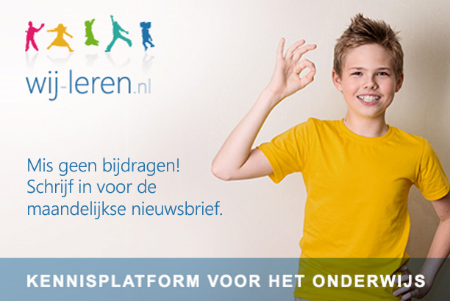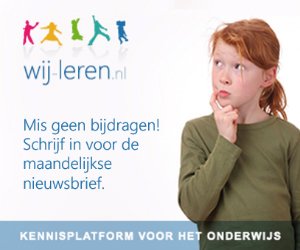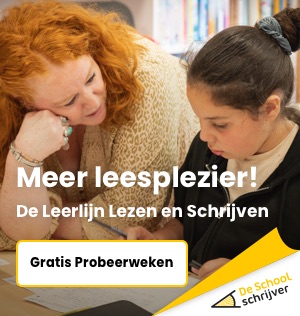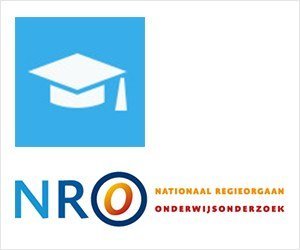Referenties
Geplaatst op 1 juni 2016
- Ainsworth, S. & VanLabeke, N. (2004). Multiple forms of dynamic representation.Learning and Instruction, 14, 241-255.
- Anderson, R.C., Pichert, J.W. & Shirey, L.L. (1983). Effects of the reader’s schema at different points in time. Journal of Educational Psychology, 75, 271-279.
- Atkinson, R.K., Derry, S.J., Renkl, A. & Wortham, D. (2000). Learning from examples: Instructional principles from the worked examples research. Review of Educational Research, 70, 181-214.
- Atkinson, R.C. & Shiffrin, R.M. (1968). Human memory: A proposed system and its control processes. In K.W. Spence & J.T.I. Spence, The psychology of learning and motivation (deel 2, pp. 89-195). New York, NY: Academic Press.
- Ayres, P. (2006). Impact of reducing intrinsic cognitive load on learning in a mathematical domain. Applied Cognitive Psychology, 20, 287-298.
- Baddeley, A.D. (1992). Working memory. Science, 255, 556-559.
- Baddeley, A.D. (1997). Human memory: Theory and practice (Red.). Hove, Verenigd Koninkrijk: Psychology Press.
- Berthold, K., Eysink, T.H.S. & Renkl, A. (2009). Assisting self-explanation prompts are more effective than open prompts when learning with multiple representations.Instructional Science, 37, 345-363.
- Boucheix, J.M., Lowe, R.K., Kemala-Putri, D. & Groff, J. (2013). Cueing animations: Dynamic signaling aids information extraction and comprehension. Learning and Instruction, 25, 71-84.
- Brand-Gruwel, S., Kester, L., Kicken, W. & Kirschner, P.A. (2014). Learning Ability Development in Flexible Learning Environments. In J.M. Spector, D.M. Merrill, J. Elen & M.J. Bishop (Red.), Handbook of Research on Educational Communications and Technology (pp. **). New York, NY: Springer.
- Brockett, R.G. (2006). Self-directed learning and the paradox of choice. International Journal of Self-directed Learning, 3(2), 27-33.
- Brockett, R.G. & Hiemstra, R. (1991). Self-direction in adult learning: Perspectives on theory, research, and practice. Londen, Verenigd Koninkrijk: Routledge.
- Camp, G., Paas, F., Rikers, R. & Merriënboer, J.J.G. van (2001). Dynamic problem selection in air traffic control training: A comparison between performance, mental effort and mental efficiency. Computers in Human Behavior, 17, 575-595.
- Carlson, R.A., Khoo, H. & Elliot, R.G. (1990). Component practice and exposure to a problem-solving context. Human Factors, 32, 267-286.
- Carlson, R.A., Sullivan, M.A. & Schneider, W. (1989). Component fluency in a problem solving context. Human Factors, 31, 489-502.
- Carroll, J.M. (2000). Making use: Scenario-based design of human-computer interactions. Cambridge, MA: MIT Press.
- Cho, Y.H. & Jonassen, D.H. (2012). Learning by self-explaining causal diagrams in high-school biology. Asia Pacific Education Review, 13(1), 171-184.
- Clarke, T., Ayres, P. & Sweller, J. (2005). The impact of sequencing and prior knowledge on learning mathematics through spreadsheet applications. Educational Technology, Research and Development, 53, 15-24.
- Corbalan, G., Kester, L. & Merriënboer, J.J.G. van (2008). Selecting learning tasks: Effects of adaptation and shared control on efficiency and task involvement.Contemporary Educational Psychology, 33, 733-756.
- Corbalan, G., Kester, L. & Merriënboer, J.J.G. van (2009). Combining shared control with variability over surface features: Effects on transfer test performance and task involvement. Computers in Human Behavior, 25, 290-298.
- Corbalan, G., Kester, L. & Merriënboer, J J.G. van (2011). Learner-controlled selection of tasks with different surface and structural features: Effects on transfer and efficiency.Computers in Human Behavior, 27, 76-81.
- Corradi, D., Elen, J. & Clarebout, G. (2012). Understanding and enhancing the use of multiple representations in chemistry education. Journal of Science Education and Technology, 21, 780-795.
- Cowan, N. (1997). Attention and memory: An integrated framework. Oxford, Verenigd Koninkrijk: Oxford University Press.
- Croock, M.B.M. de & Merriënboer, J.J.G. van (2007). Paradoxical effects of information presentation formats and contextual interference on transfer of a complex cognitive skill.Computers in Human Behavior, 23, 1740-1761.
- Croock, M.B.M. de, Merriënboer, J.J.G. van & Paas, F. (1998). High versus low contextual interference in simulation-based training of troubleshooting skills: Effects on transfer performance and invested mental effort. Computers in Human Behavior, 14, 249-267.
- Devolder, P., Pynoo, B., Voet, T., Adang, L., Vercruysse, J. & Duyck, P. (2009). Optimizing physicians’ instruction of PACS through e-learning: Cognitive load theory applied. Journal of Digital Imaging, 22(1), 25-33.
- Dufresne, R.J., Gerace, W.J., Thibodeau-Hardiman, P. & Mestre, J.P. (1992). Constraining novices to perform expertlike problem analyses: Effects on schema acquisition. The Journal of the Learning Sciences, 2, 307-331.
- Ertmer, P.A. & Newby, T.J. (1996). The expert learner: Strategic, self-regulated, and reflective. Instructional Science, 24, 1-24.
- Fowler, J. (2008). Experiential learning and its facilitation. Nurse Education Today, 28, 427-433.
- Fulgham, S.M. (2008). The effects of varying levels of support through worked examples on achievement in software application training (masterscriptie, Texas Tech University, Verenigde Staten).
- Genuchten, E. van, Scheiter, K. & Schüler, A. (2012). Examining learning from text and pictures for different task types: Does the multimedia effect differ for conceptual, causal, and procedural tasks? Computers in Human Behavior, 28, 2209-2218.
- Ginns, P. (2005). Meta-analysis of the modality effect. Learning and Instruction, 4, 313-331.
- Ginns, P. (2006). Integrating information: A meta-analysis of the spatial contiguity and temporal contiguity effects. Learning and Instruction, 16, 511-525.
- Goetz, E.T., Schallert, D.L., Reynolds, R.E. & Radin, D.I. (1983). Reading in perspective: What real cops and pretend burglars look for in a story. Journal of Educational Psychology, 75, 500-510.
- Gog, T. van, Jarodzka, H., Scheiter, K., Gerjets, P. & Paas, F. (2009). Attention guidance during example study via the model’s eye movements. Computers in Human Behavior, 25, 785-791.
- Grave, W.S. de, Schmidt, H.G. & Boshuizen, H.P.A. (2001). Effects of problem-based discussion on studying a subsequent text: A randomized trial among first year medical students. Instructional Science, 29, 33-44.
- Gulikers, J.T.M., Bastiaens, Th.J. & Martens, R.L. (2005). The surplus value of an authentic learning environment. Computers in Human Behavior, 21, 509-521.
- Gurlitt, J., Dummel, S., Schuster, S. & Nückles, M. (2012). Differently structured advance organizers lead to different initial schemata and learning outcomes. Instructional Science, 40, 351-369.
- Gurlitt, J. & Renkl, A. (2008). Are high-coherent concept maps better for prior knowledge activation? Differential effects of concept mapping tasks on high school vs. university students. Journal of Computer Assisted Learning, 24, 407-419.
- Gurlitt, J., Renkl, A., Motes, M. & Hauser, S. (2006). How can we use concept maps for prior knowledge activation – different mapping-tasks lead to different cognitive processes. In S.A. Barab, K.E. Hay & D.T. Hickey (Red.), Proceedings of the 7th International Conference of the Learning Sciences (pp. 217-221). Mahwah, NJ: Erlbaum.
- Hassanabadi, H., Robatjazi, E.S. & Savoji, A.P. (2011). Cognitive consequences of segmentation and modality methods in learning from instructional animations. Procedia – Social and Behavioral Sciences, 30, 1481-1487.
- Hatsidimitris, G. & Kalyuga, S. (2013). Guided self-management of transient information in animations through pacing and sequencing strategies. Educational Technology Research and Development, 61(1), 91-105.
- Helsdingen, A.S., Van Gog, T. & Merriënboer, J.J.G. van (2011a). The effects of practice schedule on learning a complex judgment task. Learning and Instruction, 21, 126-136.
- Helsdingen, A.S., Gog, T. van & Merriënboer, J.J.G. van (2011b). The effects of practice schedule and critical thinking prompts on learning and transfer of a complex judgment task. Journal of Educational Psychology, 103, 383-398.
- Höffler, T.N. & Schwartz, R. (2011). Effects of pacing and cognitive style across dynamic and non-dynamic representations. Computers and Education, 57, 1716-1726.
- Holland, J.H., Holyoak, K.J., Nisbett, R.E. & Thagard, P.R. (Red.) (1989). Induction: Processes of inference, learning, and discovery. Cambridge, MA: MIT Press.
- Hout-Wolters, B.H.A.M. van, Simons, P.R.J. & Volet, S.E. (2000). Active learning: Self-directed learning and independent work. In P.R.J. Simons, J. van der Linden & T. Duffy (Red.), New Learning (pp. 21-36). Dordrecht: Kluwer.
- Imhof, B., Scheiter, K., Edelmann, J. & Gerjets, P. (2012). How temporal and spatial aspects of presenting visualizations affect learning about locomotion patterns. _Learning and Instruction, 2_2, 193-205.
- Jarodzka, H., Gog, T. van, Dorr, M., Scheiter, K. & Gerjets, P. (2013). Learning to see: Guiding students’ attention via a model’s eye movements fosters learning. Learning and Instruction, 25, 62-70.
- Johnson, C.I. & Mayer, R.E. (2010). Adding the self-explanation principle to multimedia learning in a computer-based game-like environment. Computers in Human Behavior, 26, 1246-1252.
- Johnson, C.I. & Mayer, R.E. (2012). An eye movement analysis of the spatial contiguity effect in multimedia learning. Journal of Experimental Psychology: Applied, 18, 178-191.
- Jossberger, H., Brand-Gruwel, S. & Wiel, M. van de & Boshuizen, H.P.A. (2010). The Challenge of Self-Directed and Self-Regulated Learning in Vocational Education: A Theoretical Analysis and Synthesis of Requirements. Journal of Vocational Education & Training, 62, 415-440.
- Kalyuga, S. (2008). Relative effectiveness of animated and static diagrams: An effect of learner prior knowledge. Computers in Human Behavior, 24, 852-861.
- Kalyuga, S. & Sweller, J. (2005). Rapid dynamic assessment of expertise to improve the efficiency of adaptive e-learning. Educational Technology, Research and Development, 53, 83-93.
- Khacharem, A., Spanjers, I., Zoudji, B., Kalyuga, S. & Ripoll, H. (2012). Using segmentation to support the learning from animated soccer scenes: An effect of prior knowledge. Psychology of Sport and Exercise, 14, 154-160.
- Kicken, W., Brand-Gruwel, S., Merriënboer, J.J.G. van & Slot, W. (2009a). Design and evaluation of a development portfolio: How to improve students’ self-directed learning skills. Instructional Science, 37, 453-473.
- Kicken, W., Brand-Gruwel, S., Merriënboer, J J.G. van & Slot, W. (2009b). The effects of portfolio-based advice on the development of self-directed learning skills in secondary vocational education. Educational Technology, Research and Development, 57, 439-460.
- Kirschner, F., Paas, F. & Kirschner, P.A. (2009). Individual and group-based learning from complex cognitive tasks: Effects on retention and transfer efficiency. Computers in Human Behavior, 25, 306-314.
- Kirschner, F., Paas, F., Kirschner, P.A. & Janssen, J. (2011). Differential effects of problem-solving demands on individual and collaborative learning outcomes. Learning and Instruction, 21, 587-599.
- Knowles, M.S. (1975). Self-directed learning. Chicago, IL: Follett publishing company.
Kühl, T., Scheiter, K., Gerjets, P. & Edelmann, J. (2011). The influence of text modality on learning with static and dynamic visualizations. Computers in Human Behavior, 27, 29-35.
- Leahy, W., Chandler, P. & Sweller, J. (2003). When auditory presentations should and should not be a component of multimedia instruction. Applied Cognitive Psychology, 17, 401-418.
- Lee, C.H. & Kalyuga, S. (2011). Effectiveness of on-screen pinyin in learning Chinese: An expertise reversal for multimedia redundancy effect. Computers in Human Behavior, 27, 11-15.
- Leppink, J., Broers, N.J., Imbos, T., Vleuten, C.P.M. van der & Berger, M.P.F. (2012). Self-explanation in the domain of statistics: An expertise reversal effect. Higher Education, 63, 771-785.
- Limniou, M. & Whitehead, C. (2010). Online general pre-laboratory training course for facilitating first year chemical laboratory use. Cypriot Journal of Educational Sciences, 5,39-55.
- Liu, T.C., Lin, Y.C., Tsai, M.J. & Paas, F. (2012). Split-attention and redundancy effects on mobile learning in physical environments. Computers and Education, 56, 172-181.
- Machiels-Bongaerts, M., Schmidt, H.G. & Boshuizen, H.P.A. (1993). Effects of mobilizing prior knowledge on information processing: Studies of free recall and allocation of study time. British Journal of Psychology, 84, 481-498.
- Machiels-Bongaerts, M., Schmidt, H.G. & Boshuizen, H.P.A. (1995). The effect of prior knowledge activation on text recall: An investigation of two conflicting hypotheses. British Journal of Educational Psychology, 65, 409-423.
- Mautone, P.D. & Mayer, R.E. (2001). Signaling as a cognitive guide in multimedia learning. Journal of Educational Psychology, 93, 377-389.
- Mayer, R.E. (2009). Multimedia learning (tweede editie). New York, NY: Cambridge University Press.
- Mayer, R.E. & Chandler, P. (2001). When learning is just a click away: Does simple user interaction foster deeper understanding of multimedia messages? Journal of Experimental Psychology, 93, 390-397.
- Mayer, R.E. & Moreno, R. (2003). Nine ways to reduce cognitive load in multimedia learning. Educational Psychologist, 38, 43-52.
- Mayer, R.E., Mathias, A. & Wetzell, K. (2002). Fostering understanding of multimedia messages through pre-training: Evidence for a two-stage theory of mental model construction. Journal of Experimental Psychology: Applied, 8, 147-154.
- Merriënboer, J.J.G. van (1990). Strategies for programming instruction in high school: Program completion vs. program generation. Journal of Educational Computing Research, 6, 265-285.
- Merriënboer, J.J.G. van & Croock, M.B.M. de (1992). Strategies for computer-based programming instruction: Program completion vs. program generation. Journal of Educational Computing Research, 8, 365-394.
- Merriënboer, J.J.G. van & Kirschner, P.A. (2013). Ten steps to complex learning (tweede herziene uitgave). New York, NY: Routledge.
- Merriënboer, J.J.G. van & Luursema, J.J. (1996). Implementing instructional models in computer-based learning environments: A case study in problem selection. In T.T. Liao (Red.), Advanced educational technology: Research issues and future potential (pp. 184-206). Berlijn, Duitsland: Springer Verlag.
- Merriënboer, J J.G. van, Schuurman, J.G., de Croock, M.B.M. & Paas, F. (2002). Redirecting learners’ attention during training: Effects on cognitive load, transfer test performance and training efficiency. Learning and Instruction, 12, 11-37.
- Merriënboer, J.J.G. van & Sweller, J. (2005). Cognitive load theory and complex learning: Recent developments and future directions. Educational Psychology Review, 17, 147-177.
- Merriënboer, J.J.G. van & Vleuten, C.P. van der (2012). Technology-based assessment in the integrated curriculum. In M.C. Mayrath, J. Clarke-Midura, D.H. Robinson & G. Schraw (Red.), Technology-based assessments for 21st century skills (pp. 245-370). Greenwich, CT: Information Age Publishing.
- Miller, G.A. (1956). The magical number seven, plus or minus two: Some limits on our capacity for processing information. Psychological Review, 63(2), 81–97.
- Moussa-Inaty, J., Ayres, P.L. & Sweller, J. (2012). Improving listening skills in English as a foreign language by reading rather than listening: A cognitive load perspective. Applied Cognitive Psychology, 26, 391-402.
- Musallam, R. (2010). The effects of using screencasting as a multimedia pre-training tool to manage the intrinsic cognitive load of chemical equilibrium instruction for advanced high school chemistry students (masterscriptie, University of San Francisco, Verenigde Staten).
- Nokes, T.J., Hausmann, R.G.M., VanLehn, K. & Gershman, S. (2011). Testing the instructional fit hypothesis: The case of self-explanation prompts. Instructional Science, 39, 645-666.
- Olina, Z., Reiser, R.A., Huang, X., Lim, J. & Park, S. (2006). Problem format and presentation sequence: Effects on learning and mental effort among US high school students. Applied Cognitive Psychology, 20, 299-309.
- Paas, F. & Merriënboer, J.J.G. van (1994). Variability of worked examples and transfer of geometrical problem-solving skills: A cognitive-load approach. Journal of Educational Psychology, 86, 122-133.
- Paivio, A. (1986). Mental representation: A dual coding approach. New York, NY: Oxford University Press.
- Palmeri, T.J. (1999). Theories of automaticity and the power law of practice. Journal of Experimental Psychology: Learning, Memory, and Cognition, 25, 543-551.
- Perkins, D.N. & Salomon, G. (1989). Are cognitive skills context-bound? Educational Researcher, 18, 16-25.
- Pollock, E., Chandler, P. & Sweller, J. (2002). Assimilating complex information. Learning and Instruction, 12, 61-86.
- Quilici, J.L. & Mayer, R.E. (1996). Role of examples in how students learn to categorize statistics word problems. Journal of Educational Psychology, 88, 144-161.
- Rasch, T. & Schnotz, W. (2009). Interactive and non-interactive pictures in multimedia learning environments: Effects on learning outcomes and learning efficiency. Learning and Instruction, 19, 411-422.
- Renkl, A. (1999). Learning mathematics from worked-out examples: Analyzing and fostering self-explanations. European Journal of Psychology of Education, 14, 477-488.
- Renkl, A., Atkinson, R.K. & Grosse, C.S. (2004). How fading worked solution steps works – A cognitive load perspective. Instructional Science, 32, 59-82.
- Rey, G.D. (2012). A review of research and a meta-analysis of the seductive details effect. Educational Research Review, 7, 216-237.
- Roelle, J. & Berthold, K. (in druk). The expertise reversal effect in prompting focused processing of instructional explanations. Instructional Science. DOI 10.1007/s11251-012-9247-0
- Salden, R.J.C.M., Paas, F. & Merriënboer, J.J.G. van (2006). A comparison of approaches to learning task selection in the training of complex cognitive skills.Computers in Human Behavior, 22, 321-333.
- Salden, R J.C.M., Paas, F., Broers, N.J. & Merriënboer, J J.G. van (2004). Mental effort and performance as determinants for the dynamic selection of learning tasks in air traffic control training. Instructional Science, 32, 153-172.
- Scheiter, K., Gerjets, P., Huk, T., Imhof, B. & Kammerer, Y. (2009). The effects of realism in learning with dynamic visualizations. Learning and Instruction, 19, 481-494.
- Schmidt, H.G., Volder, M.L. de, Grave, W.S. de, Moust, J.H.C. & Patel, V.L. (1989). Explanatory models in the processing of science text: The role of prior knowledge activation through small-group discussion. Journal of Educational Psychology, 81, 610-619.
- Schmidt-Weigand, F., Kohnert, A. & Glowalla, U. (2010). A closer look at split visual attention in system- and self-paced instruction in multimedia learning. Learning and Instruction, 20, 100-110.
- Schnotz, W. & Rasch, T. (2005). Enabling, facilitating, and inhibiting effects of animations in multimedia learning: Why reduction of cognitive load can have negative results on learning. Educational Technology, Research and Development, 53, 47-58.
- Seufert, T., Schütze, M. & Brünken, R. (2009). Memory characteristics and modality in multimedia learning: An aptitude-treatment-interaction study. Learning and Instruction, 19, 28-42.
- Spanjers, I.A.E., Gog, T. van, Wouters, P, & Merriënboer, J.J.G. van(2012). Explaining the segmentation effect in learning from animations: The role of pausing and temporal cueing. Computers and Education, 59, 274-280.
- Spanjers, I.A.E., Wouters, P. Gog, T. van & Merriënboer, J.J.G. van (2011). An expertise reversal effect of segmentation in learning from animated worked-out examples.Computers in Human Behavior, 27, 46-52.
- Sung, E. & Mayer, R.E. (2012). Affective impact of navigational and signaling aids to e-learning. Computers in Human Behavior, 28, 473-483.
- Sweller, 1988: Sweller, J. (1988). Cognitive load during problem solving: Effects on learning. Cognitive Science, 12(2), 257-285.
- Sweller, J., Merriënboer, J.J.G. van & Paas, F. (1998). Cognitive architecture and instructional design. Educational Psychology Review, 10, 251-296.
- Tabbers, H.K. (2002). The modality of text in multimedia instructions. Refining the design guidelines (masterscriptie, Open Universiteit).
- Tabbers, H.K., Martens, R.L. & Merriënboer, J.J.G. van (2004). Multimedia instructions and cognitive load theory: Effects of modality and cueing. British Journal of Educational Psychology, 74(1), 71-82.
- Taminiau, E.M.C. (2013). Advisory models for on-demand learning (masterscriptie, Open Universiteit).
- Ternier, S., De Vries, F., Börner, D. & Specht, M. (2012). Mobile augmented reality with audio, supporting fieldwork of Cultural Sciences students in Florence. In G. Eleftherakis, M. Hinchey & M. Holcombe (Red.), Software Engineering and Formal Methods – Proceedings of 10th International Conference, SEFM 2012 (pp. 367-379). Heidelberg, Duitsland/Dordrecht: Springer.
- Veenman, M.V.J., Van Hout-Wolter, B.H.A.M. & Afflerbach, P. (2006). Metacognition and learning: Conceptual and methodological considerations. Metacognition & Learning, 1, 3-14.
- Westelinck, K. de, Valcke, M., Craene, B. de & Kirschner, P. (2005). The cognitive theory of multimedia learning in the social sciences knowledge domain: Limitations of external graphical representations. Computers in Human Behavior, 21, 555-573.
- Wetzels, S. (2009). Individualised strategies for prior knowledge activation(masterscriptie, Open Universteit).
- Wickens, C.D., Hutchins, S., Carolan, T. & Cumming, J. (2013). Part task training and increasing difficulty training strategies: A meta-analysis approach. Human Factors: The Journal of the Human Factors and Ergonomics Society, 55, 461-470.
- Willoughby, T., Wood, E., Desmarais, S., Sims, S. & Kalra, M. (1997). Mechanisms that facilitate the effectiveness of elaboration strategies. Journal of Educational Psychology, 89, 682-685.
- Yeh, Y.F., Chen, M.C., Hung, P.H. & Hwang, G.J. (2010). Optimal self-explanation prompt design in dynamic multi-representational learning environments. Computers and Education, 54, 1089-1100.
- Zimmerman, B.J. (2000). Attaining self-regulation. A social cognitive perspective. In M. Boekaerts, P.R. Pintrich & M. Zeidner (Red.), Handbook of self-regulation (pp. 13-39). San Diego, CA: Academic Press.
- Zimmerman, B.J. (2006). Development and adaptation of expertise: The role of self-regulatory processes and beliefs. In K.A. Ericsson, N. Charness, P.J. Feltovich & R.R. Hoffman (Red.), The Cambridge handbook of expertise and expert performance (pp. 683-703). New York, NY: Cambridge University Press.
Heb je vragen over dit thema? Stel ze in de onderwijs community binnen de Wij-leren.nl Academie!
Details van het onderzoek
| NWO-projectnummer: | |
| Titel onderzoeksproject: | |
| Looptijd: | 30-11--0001 tot 30-11--0001 |
[Bron: Nationaal Regieorgaan Onderwijsonderzoek (NRO)]






